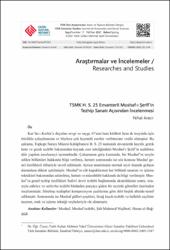TSMK H. S. 25 Envanterli Mushaf-ı Şerîf’in Tezhip Sanatı Açısından İncelenmesi
Citation
ARACI, Nihal. " TSMK H. S. 25 Envanterli Mushaf-ı Şerîf’in Tezhip Sanatı Açısından İncelenmesi". FSM İlmi Araştırmalar İnsan ve Toplum Bilimleri Dergisi, 17 (2021): 1-34.Abstract
Kur’ân-ı Kerîm’e duyulan sevgi ve saygı, O’nun hem kitâbeti hem de tezyinâtı için
titizlikle çalışılmasına ve böylece çok kıymetli eserler verilmesine vesîle olmuştur. Bu
çalışma, Topkapı Sarayı Müzesi Kütüphanesi H. S. 25 numaralı envanterde kayıtlı, gerek
hattı ve gerek tezhibi bakımından kaynak eser niteliğindeki Mushaf-ı Şerîf’in tezhibine
dâir yapılan incelemeyi içermektedir. Çalışmanın giriş kısmında, bir Mushaf’ın tezyîn
edilen bölümleri hakkında bilgi verilmiş, hemen sonrasında ise söz konusu Mushaf genel
özellikleri itibariyle tavsif edilmiştir. Ayrıca tasarımının normal seyri dışında gelişen
durumlara dikkat çekilmiştir. Mushaf’ın cilt kapaklarının her bölümü tasarım ve işleme
teknikleri bakımından anlatılmış, hattatı ve müzehhibi hakkında da bilgi verilmiştir. Mushaf’ın
genel tezhip özellikleri Safevî devri tezhibi bağlamında aktarıldıktan sonra, sırasıyla
zahriye ve serlevha tezhibi bütünden parçaya giden bir seyirde görseller üzerinden
incelenmiştir. Sûrebaşı tezhipleri kompozisyon çeşitlerine göre dört başlık altında tasnif
edilmiştir. Sonrasında ise Mushaf gülleri çeşitleri, ferağ kaydı tezhibi ve halkârlı sayfalar
tasarım, renk ve işleme tekniği veçheleriyle ele alınmıştır. The love and respect for the Koran has resulted in meticulous work for both its inscription
and decoration, and conduced to the creation of very valuable works. This study
also includes the examination of the illumination of the Koran, which is registered in the
inventory no. H. S. 25 of the Topkapı Palace Museum Library, is a reference work in terms
of both its calligraphy and illumination. In the introduction part of the study, information
is given about the decorated parts of a Koran, and immediately after that, the Koran
in question is described in terms of its general features. In addition, outliars of the normal
design situations are highlighted. Each part of the Koran’s binding is described in terms of
design and production techniques, and information about its calligrapher and illuminator
is also given. After the general illumination characteristics of the Koran are conveyed in
the context of the Safavid period illumination, its zahriye and serlevha illumination are
examined through the visuals in a course from the whole to the piece. Sûrebaşı illuminations
are classified under four headings according to their design varieties. Afterwards,
the varieties of Koran roses, the ferağ record illumination and the pages with halkâr have
been discussed in terms of design, color and production technique.



















